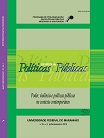EVIDÊNCIAS EMPÍRICAS SOBRE CONVERGÊNCIA DA DESIGUALDADE DE RENDA ENTRE OS MUNICÍPIOS CEARENSES
DOI :
https://doi.org/10.18764/2178-2865.v18n2p557-571Mots-clés :
Desigualdade de renda, Índice de Gini, efeitos ThresholdRésumé
A desigualdade de renda tende a diminuir em municípios com elevada desigualdade e a aumentar naqueles com baixa desigualdade? Este trabalho tenta responder a essa questão ao verificar se existiu convergência da desigualdade de renda entreos municípios cearenses, nos anos 1991 e 2000. A principal medida de desigualdade de renda utilizada foi o índice de Gini, sendoos testes de convergência realizados por meio de modelos com efeito threshold, nos quais as variáveis concernentes ao índice deGini, à renda per capita e aos anos de estudo, medidas no período inicial, foram consideradas como possíveis variáveis threshold. Os resultados permitiram rejeitar a hipótese de clubes de convergência da desigualdade de renda entre os municípios cearenses. Noentanto, não se pode rejeitar a hipótese de convergência condicional da desigualdade de renda entre os mesmos, sendo que eles estariam convergindo para um valor médio de equilíbrio de desigualdade de renda maior, ou seja, os municípios cearenses estariam tornando-se mais concentradores de renda per capita.
Palavras-chave: Desigualdade de renda, Índice de Gini, efeitos Threshold.
EMPIRICAL EVIDENCES ABOUT THE CONVERGENCE OF INCOME INEQUALITY AMONG CITIES FROM CEARA
Abstract: The income inequality tends to decrease in municipalities with high inequality and increase in those with low inequality? This paper intends to answer this question by checking if there was convergence of income inequality in the municipalities of the State of Ceará, in the years 1991 and 2000. The main measurement of income inequality used was the Gini index, with the convergencetests conducted through models with threshold effect, in which the variables relating to the Gini index, to the per capita income and to the years of study were considered, measured in the initial period as possible threshold variables. The results allowed rejectingthe hypothesis of convergence clubs of the per capita income inequality among the cities from Ceará. However there is no way to reject the hypothesis of conditional convergence of the income inequality in the municipalities among the same, where these would be converging to an average value of the bigger income inequality, that is, they would be turning themselves into more per capita income-concentrating municipalities.
Key words: Income inequality, Gini Index, Threshold effect.
Téléchargements
Téléchargements
Publié-e
Comment citer
Numéro
Rubrique
Licence
UNIVERSIDADE FEDERAL DO MARANHÃO
PROGRAMA DE PÓS-GRADUAÇÃO EM POLÍTICAS PÚBLICAS
REVISTA DE POLÍTICAS PÚBLICAS
Termo de Transferência de Direitos Autorais
Como condição para a submissão, os autores devem declarar a autoria do trabalho e concordar com o Termo de Cessão de Direitos Autorais, marcando a caixa de seleção após a leitura das cláusulas)
- Declaro que participei da elaboração do trabalho referido, em parte ou no todo; que não omiti qualquer ligação ou acordo de financiamento entre os autores e instituições ou empresas que possam ter interesses na publicação desse trabalho;
- Declaro tratar-se de texto original, isento de compilação, em parte ou na íntegra, de minha autoria ou de outro (os) autor (es);
- Declaro que o texto não foi enviado a outra revista (impressa ou eletrônica) e não o será enquanto a possibilidade de sua publicação esteja sendo considerada pela RPP;
- Declaro que transfiro os direitos autorais do trabalho especificado para a RPP, comprometendo-me a não reproduzir o texto, total ou parcialmente, em qualquer meio de divulgação, impresso ou eletrônico, sem prévia autorização dessa Revista.
- Declaro que tenho conhecimento que a cessão do texto à RPP é gratuita e, portanto, não haverá qualquer tipo de remuneração pela sua utilização.

Este obra está licenciado com uma Licença Creative Commons Atribuição-NãoComercial-SemDerivações 4.0 Internacional.







